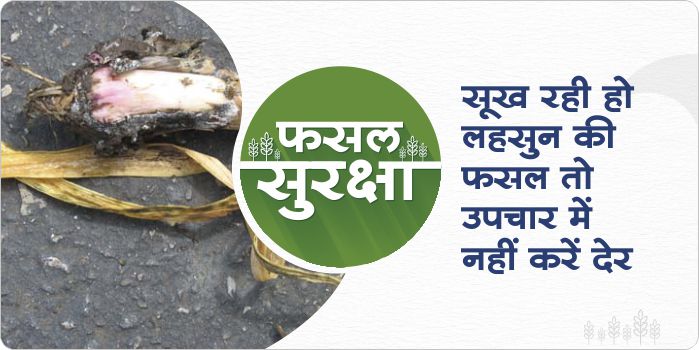- Weeds cause heavy damage to the wheat crop as they get their requirement of nutrients and moisture directly from soil and plants.
- And thus competing with crop plants for light and space, thereby reducing crop yields
- Bathua (Chenopodium album), Gehu ka mama (Phalaris minor), Wild Oats ( Avena fatua), Pyajii (Asphodelus tenuifolius) etc. cause serious problems in wheat fields. In addition, Dub (Cynodon dactylon) is a major perennial weed.
- Use of the following products is very important to control these weeds.
- Spray of 2,4-D amine salt 58% @ 400 ml/acre in 25-30 days after sowing.
- Spray Metsulfuron methyl @ 20% WP @ 8 gram/acre within 30 days of sowing. After its use, 3 irrigation must be done.
- Spray Clodinafop propargyl 15% + Metsulfuron methyl 1% WP @ 160 gram/acre.
- Spray of Clodinafop propargyl @ 15% WP @ 160 gram/acre during 30-35 days of sowing.
How to prevent root rot problems in garlic crops
- Garlic crops are facing many problems because of the changes in the weather and humidity.
- Due to this, the problem of root rot disease is being seen a lot.
- In this disease, the plant stops growing and the leaves turn yellow and the plant dries from top to bottom.
- In the early stage of infection, the roots of plants begin to dry up. The lower end of the bulb begins to rot and eventually the entire plant dies.
- It is very important to use the following products to prevent this problem
- For the prevention of this disease Carbendazim 12% + Mancozeb 63% WP @ 300 gram / acre or Kasugamycin 5% + Copper oxychloride 45% WP @ 300 gram / acre or Chlorothalonil 75% WP @ or 400 gram / acre or Thiophene methyl 70% W/W @ 300 gram / acre.
- Biological treatment: –
- Spray Trichoderma viride @ 500 gram / acre or Pseudomonas fluorescens @ 250 gram/acre as a biological treatment.
Early blight management in potato crop
- The problem of burning plants in potato crops occurs due to early blight disease.
- Early blight starts in early December.
- This disease is caused by a fungus known as Alternaria solani.
- Initially brown colored spots with centric rings are formed on the leaves.
- The spots gradually grow in size,later covering the entire leaf and finally the plant dies.
Chemical treatment:
Azoxistrobin 11% + Tebuconazole 18.3% SC @ 300 ml / acre or Kasugamycin 5% + Copper oxychloride 45% WP @ 300 gram / acre or Metalaxyl 4% + Mancozeb 64% WP @ 600 gram / acre or Tebuconazole 10% + Sulfur 65% Spraying at the rate of WG @ 500 gram / acre.
Biological treatment:
Use Trichoderma viridi @ 500 g / acre or Pseudomonas fluorescence @ 250 gram / acre.
ShareImportance of white roots for good crop production
- For the good production of the crop, the development of white roots is necessary.
- The white root holds soil well, which is necessary to avoid soil erosion.
- Because of these roots transportation of nutrients is easy to upper part of plants
- White root is long and divided into many parts which helps in water circulation.
- For good growth of white roots, it is very important to have a certain amount of phosphorus in the soil, so it is advisable to use phosphorus in the field at the time of soil preparation.
Importance of magnesium for plants
- Magnesium plays an important role in the food production process of plants and it is the major element behind greenness of the leaves. Magnesium (Mg) also plays an important role in many enzyme activities in plants and development of plant tissues.
- The average amount of magnesium in the soil is 0.5 – 40 g / kg, but at present, the amount of magnesium in most soils is found to be 0.3 – 25 g / kg.
- The first signs of magnesium deficiency appear on the old leaves below, the veins of the leaves get dark colored and the middle part of the veins becomes yellowish red.
- Deficiency of nitrogen in the soil increases magnesium deficiency.
- While preparing the field, mix 10 kg/acre of magnesium sulfate (9.5%) in the soil thoroughly with basal dose .
- To cure magnesium deficiency, make a solution of magnesium sulfate at the rate of 250 g / acre and spray it on the leaves twice weekly.
Different stages of irrigation in wheat crops
- First irrigation at 20-25 days of sowing (Crown root stage).
- Second irrigation at 40-50 days of sowing (Tillering stage)|
- Third irrigation at 60-65 days of sowing (Jointing stage )
- Fourth irrigation at 80-85 days of sowing ( flowering stage)|
- Fifth irrigation at 100-105 days of sowing (milking stage)
- Sixth irrigation should be done at 115-120 days of sowing ( Dough stage).
- In case of three irrigations, irrigate at crown root stage, jointing stage and milking stage.
How to control frost in gram crop
- The long nights of winter are cold and sometimes the temperature can even drop to freezing point or below it. In such a situation the water vapor, without converting into liquid directly, gets converted into minute ice particles, which is known as frost and it can be very harmful for flora and crops .
- Leaves and flowers of plants appear scorched due to the effect of frost which later causes them to fall. Even half-ripe fruits shrink. They wrinkle, the bud falls and the formation of grain is hindered.
- To protect your crop from frost, you create smoke around your field, so that the temperature will be balanced and the crop can be saved from frost damage.
- On the day when there is a possibility of frost, spray 0.1% solution of sulfur on the crop . Keep in mind that the spray of solution covers plants well. The effect of spray lasts for two weeks. If there is a possibility of cold wave and frost even after this period, spray of sulfur should be repeated at an interval of 15 to 20 days.
- As a biological treatment Pseudomonas Fluorescens @ 500 gram/acre
Late blight management in potato
- The disease spreads by Phytophthora fungus. Potato late blight is a pandemic disease that can extremely affect potato crop.
- Late blight destroys the green leaves of plants within 5 days.
- In this disease, spots start to appear on the edges of the leaf and gradually spread all over it, branches and stems also get affected and later the tubers as well. On the lower surfaces of the leaves white color shells are formed, which later turn brown and black.
- Due to the infection of the leaves, the size of potato tubers is reduced and production decreases and the entire field is destroyed when the weather gets favorable for the disease.
- Metalaxyl 30% FS @ 10 gram should be dissolved in 10 liters of water and dipped in seeds and treated and dried it.
- Use Chlorothalonil 75% WP @ 250 gram/acre or Metalaxyl 4 % + Mancozeb 64% WP @ 250 gram/acre or Tebuconazole 10% + Sulphur(s) 65% WG @ 500 gram/acre or Kasugamycin 5% + Copper Oxychloride 45% WP @ 300 gram/acre
- As a biological treatment Pseudomonas Fluorescens @ 250 gram/acre or Trichoderma Viride @ 500 gram/acre.
How to choose the right seed in cabbage crop
- Temperature is a very important factor in maturing Cole crop varieties.
- Sowing of seeds of every variety requires temperatures up to 27 degrees.
- Cabbage varieties are divided into four types according to the temperature requirement for good crop production.
- Cabbage crop seeds come in four varieties: Early maturing varieties, medium maturing varieties, medium late maturing varieties, late maturing varieties.
Importance of Boron in cauliflower
- The use of micro-elements in cauliflower increases production and productivity. Boron is an important element
- Boron deficiency causes the Cabbage flower to turn light pink or bitter in taste
- Use Borax or boron 5 kg / acre, along with other fertilizers, If 2-4 grams of borax per liter of water is sprayed on the crop, then good flowers are obtained and good yields can be expected.
- Prevents Cauliflower from becoming hollow and brown and increases yield.










